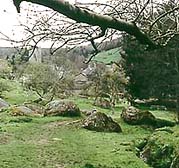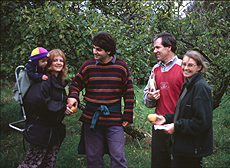![]() The Orchards Path
The Orchards Path
New Uses For Old Orchards


![]() Camping
Camping
Peter and Pat Hinde own a pick-your-own orchard and fruit farm near Iver in Buckinghamshire. Part of their land is used for caravanning, as Peter explains:
My arrangement for caravans is with the Caravan Club who licence the site. I have to have half an acre dedicated to caravans, supply water, household rubbish disposal and a cesspit for disposing of the contents of their WCs. I cannot let any caravan remain for more than 28 days at a time, nor have more than five on the site at any one time. They must be slept in, not stored. I take telephone bookings and customers must be members of the Caravan Club and give me their membership number on booking. I charge £4.50 a night, £28 for seven days. I do not provide electricity though if anyone wants to charge a battery, I show them where the plug is.
![]() Nature conservation
Nature conservation
In some counties, old orchards are among the few remaining places where biodiversity is exactly that. There are orchard nature reserves run by the Wildlife Trusts in Worcestershire (Melrose Farm), Hertfordshire (Tewin), Essex (Sergeant’s) and Dorset (Broad Oak, above right). On the whole, orchards have rarely been viewed by conservation organisations as suitably wild or natural enough to justify their protection as nature reserves or as subjects for special designation. This is a lost opportunity, since many orchards, particularly old ones which have occupied the same piece of land for many years, may be perfect habitats for rare and common species alike. This notion continues to be borne out following Common Ground’s Orchard Observances scheme which encourages the keeping of orchard naturediaries by their owners or users. As orchards enjoy greater scrutiny, the more evidence of their value to biodiversity emerges.
![]() Horticultural training
Horticultural training
Brighton resident and MIND volunteer Liz Godden had attended an Orchards Training Day in London organised by Common Ground and the Federation of City Farms and Community Gardens. This excited her into thinking about the old orchard at Stanmer Park, on the northern fringe of Brighton. The 0.4-hectare orchard was once part of the private Stanmer Estate and is now owned by Brighton and Hove Council. While the parkland, house and walled gardens have continued to be used as a public park and council nursery, the orchard had fallen into neglect and the grassland beneath the trees was a mass of nettles, brambles, dogwood and Japanese knotweed. An area directly adjacent to the orchard is used by various voluntary sector organisations and community projects, providing horticultural training for people with learning difficulties and mental health problems. Liz began exploring ways to restore the orchard for public access and to bring it back into fruitfulness by working with the various groups active in Stanmer and the wider community. She called a meeting of local people and groups associated with the park and the local countryside, which resulted in the formation of the Stanmer Orchard Group (SOG). The council were supportive and a management plan was drawn up in 1999 / 2000.
Three members of the group applied for a BTCV Natural Pioneers Millennium Award to fund training including apple tree care, bird-box making and flora and fauna identification. Clearing some of the vegetation beneath the trees has encouraged an increase in bluebells and the appearance of orchids. Gentle pruning has reinvigorated the fruit bearing of the trees. The work of SOG will make the orchard an attractive place for people to visit, linger in and eat from in the coming years.
![]() Al fresco
Al fresco
The old perry orchard at Warndon is now surrounded by new estates built on Worcester’s eastern edge. Huge trees well populated by invertebrates and birds can be admired and enjoyed by their new human neighbours. There is open access at all times and people are encouraged to walk, play and picnic. The locally distinctive perry fruit may not be palatable but offers local home-brewers a new challenge. Visitors to Granchester, Rupert Brooke’s home village near Cambridge, can enjoy a cuppa beneath apple trees in the Orchard Tea Gardens, originally planted in 1868.
![]() Arenas for celebration
Arenas for celebration
Lustleigh Orchard on the edge of Dartmoor (above, left) anticipated the idea of Community Orchards. It was bequeathed to the parish as an existing cider orchard in 1960 and it sits at the centre of the village. Local people believe that it has been an orchard for as long as there has been settled agriculture in the valley. The orchard is the largest area of green space within the parish and is the focus of community celebrations such as the annual May Day festival, where the May Queen is crowned. The orchard is owned and looked after by the parish council, and as old trees die they are replaced with new stock. An income is gained from selling part of the apple crop (locals are free to take what they like for their own use), letting the orchard to graze sheep and by selling mistletoe. A small donation box on the orchard gate also raises money to help with maintenance.
If you have a Community Orchard, please let us know -
email info [at] commonground.org.uk.